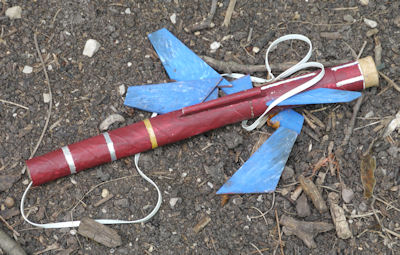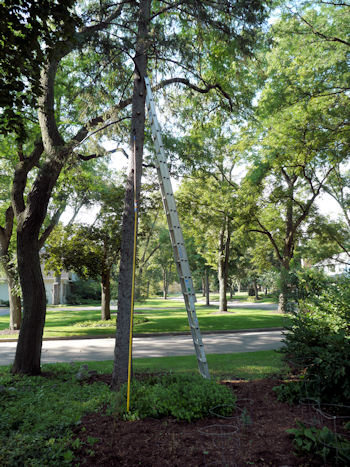“How can I retrieve a rocket stuck in a tree?” is the most dreaded question a rocket enthusiastic can ask, second only to “Where did it go?”
This story is about my multiple epic failures in trying to bring down a rocket, which hopefully you can learn from.
We were on our way to dinner one evening, when my wife casually hands me a hand-painted blue tail fin from a model rocket. “Oh, I found that in the garden,” she said. “What!?!” I exclaimed, “Where there is one piece of rocket on the ground, there’s more rocket to be found. How can we think of food at a time like this?”
Despite my protests, I had to wait until after dinner to search for the rocket. Here’s what I found...

Airframe of model rocket on the ground.
The nose cone and parachute were missing, but the hand-decorated body tube suggested that somebody put a lot of love into building it. A scan of the area revealed nothing more.
A few weeks later, my son was lounging on the couch, looking out at a wooded area. “There’s a plastic bag in the tree,” he said leisurely. “What!?!” I exclaimed, “That’s no bag; that’s a parachute!”


Payload and parachute of model rocket stuck in a pine tree.
That rocket is way up high, in the rolie-polie sky!
I used a laser pointer, level, protractor, and measuring tape to roughly determine the height of the rocket in the tree limb. At a distance of 33 feet from the tree, the angle to the rocket was 47.5°. A little trigonometry calculates the height:
height = tan angle × distance
height = tan 47.5 × 33 feet
height = 36 feet
36 feet may not seem like much on paper, but that’s higher than most two story homes.
I spent the next couple of weeks thinking up elaborate plans for retrieving the rocket, such as a tree-climbing robot. Secretly, I hoped the rocket would simply fall out of the tree on a windy day.
One Saturday, my desire to obtain the rocket outweighed my desire to do so in an ingenious way. I simply wanted the rocket.
I grabbed a bunch of bamboo poles and taped them together with duct tape. The plan was to lift up the parachute and rocket, maneuver it over a bare spot, and then lower it down. This out-of-focus photo sums up how well that turned out.

Awful photograph of bamboo poles connected together with duct tape.
After the third or fourth bamboo pole was attached, the weight caused each pole to sag at the joints. Further duct tape was added, along with a little more overlap between poles, in a worthless attempt to connect the poles more securely.
The poles themselves also drooped under the weight. At some point, the bamboo formed an arch instead a straight pole (∩ instead of |). Upon adding the sixth pole (nearly 36 feet) and trying to lift it straight, the bamboo simply broke.
To add insult to injury, unbeknownst to me, my camera was in manual focus mode when I took the above picture. You can imagine my frustration when I uploaded the photos into my computer, only to be greeted by that lovely vision. This realization occurred only after I had arduously removed all of the duct tape and stored the poles.
A week later, it struck me that the model rocket could easily be rescued by a party balloon. After all, I needed something to go up, and balloons go up, so this should be simple.

Curious George balloon to the rescue.
The Curious George Mylar balloon is tied to a light wooden rod with a hook at the end. The center and the end of the rod have monofilament fishing lines attached, such that the middle line controls height and the end line controls angle.

Balloon on the way to rescue a rocket. Do you see it? Do you see the little white parachute?
All I need to do is:
This is going to be a snap. I love this plan. I can’t wait.
Okay, George, you’re almost there...

Rocket rescue hampered by the wind.
Oh no! The slightest little breeze blows the balloon off target.
I tried again and again for almost two hours. Worse yet, the fishing line and hook constantly snagged on other branches of the pine tree.
Lesson learned: A balloon is a lousy way to rescue a rocket.
(At some point, Curious George developed a leak from too many brushes against the branches. It slowly became saggy and less effective. It was very depressing.)
That is it! I’m fed up. Time for a good-old-fashioned ladder.

Ladder and bulb changing extension pole. (The rocket isn’t even visible in this picture. It is higher up.)
It occurred to me about halfway up, that if I fall and hurt myself, I’m going to need a much better story for my insurance company than “There was this really cool rocket stuck in a tree and I wanted it.” I decided on mumbling something about trimming dead branches.
In all seriousness, I came to my senses at about 25 feet, and decided it was foolish to risk my safety. The rest of the job was completed by attaching a coat hanger hook to a bamboo pole to the end of an aluminum telescoping light-bulb changer.

Hook made from coat hanger taped to a bamboo pole.
Having learned from the earlier duct tape failure, I attached the bamboo pole to the light-bulb changer using cable ties. (There’s some masking tape to avoid minor rotational forces, but the plastic cable ties bear most of the load.)

Poles connected with cable ties.
The cable ties worked really well.
Success! Victory!

Model rocket rescued from a tree.
The entire rocket appears to be handmade, as opposed to a kit rocket. (Nope! John Caswell pointed out that the rocket is an Estes Star Stryker.) It is hand-painted with an awesome (but empty) clear payload tube.
The body tube has warped slightly due to rain, but is still serviceable. This rocket could fly again with a little glue and a replacement shock cord.

Homemade parachute.
The parachute appears to be made out of a plastic garbage bag. The speed hole in the middle is designed to reduce fall time so that the rocket doesn’t drift away and land in a tree. (Judge for yourself how well that worked out.)

Hand cut center hole and hole punch reinforcement.
The corners of the parachute have reinforcements that look like they are paper hole punch protectors. Unfortunately, the parachute holes were all damaged during retrieval, as the parachute string was tangled in the branches. In fact, the parachute strings are still up in the tree, taunting me to this day.
I realize this article has nothing to do with electronics or robots. But, it has a little bit of science, math, and physics. More importantly, it reminds everyone that success sometimes comes from sheer perseverance and will power, rather than complexity and ingenuity.
If you are the boy or girl that built this model rocket, perhaps with your mother, father, or other family members, contact me so that I can happily return it to you. Ummm... something bad happened to the rocket.